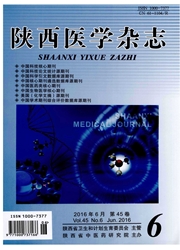

 中文摘要:
中文摘要:
目的:分析纳洛酮用于治疗感染性休克时对患者肾脏功能的影响。方法:选择ICU感染性休克患者43例,其中21例在治疗过程中使用了纳洛酮,为A组;另22例为按照病情相近、病因相同、年龄相仿的原则选取的未使用纳洛酮者作为对照,为B组。分析比较两组患者肾功相关指标的变化。结果:治疗前,所有患者均有少尿,尿白蛋白、尿β2-微球蛋白定量及血尿素氮和肌酐水平均明显高于正常,但两组之间比较均无显著性差异;经过治疗,所有患者的尿量、血尿素氮和肌酐水平均恢复到正常水平,而尿白蛋白、尿β2-微球蛋白定量明显下降,以A组患者的下降更为显著。结论:纳洛酮用于感染性休克患者时,对肾脏功能有一定的保护作用。
 英文摘要:
英文摘要:
Objective: This article aimed at studying the effect of naloxone on the renal function when applied to the patients with septic shock. Methods: Fourty -- three patients with septic shock, who were admitted into ICU of our department, were studied in this article. Of all, 21 cases administered with naloxone were sampled as Group A, and other 22 cases who had similarity to Group A in their condition, cause as well as age were sampled as Group B. The indices in the renal function were compared and analyzed between the two groups. Results: Oliguria and the abnormally higher level in the blood urea nitrogen, creatinine as well as the urine albumin and urine β2-microglobulin output occurred in all patients before anti-shock therapy was given, and with no statistically significant difference between the two groups. After anti--shock therapy began, urine output, blood urea nitrogen and creatinine returned to their normal levels, while the urine albumin and β2-microglobulin output declined significantly with statistically significant difference between the two groups. The more markedly decreased level in the urine albumin and urine β2-microglobulin output occurred in the patients of Group A. Conclusion: Naloxone could play a beneficial role in the maintenance of circulatory stability, and had a protective action on the renal function.
 同期刊论文项目
同期刊论文项目
 同项目期刊论文
同项目期刊论文
 期刊信息
期刊信息
